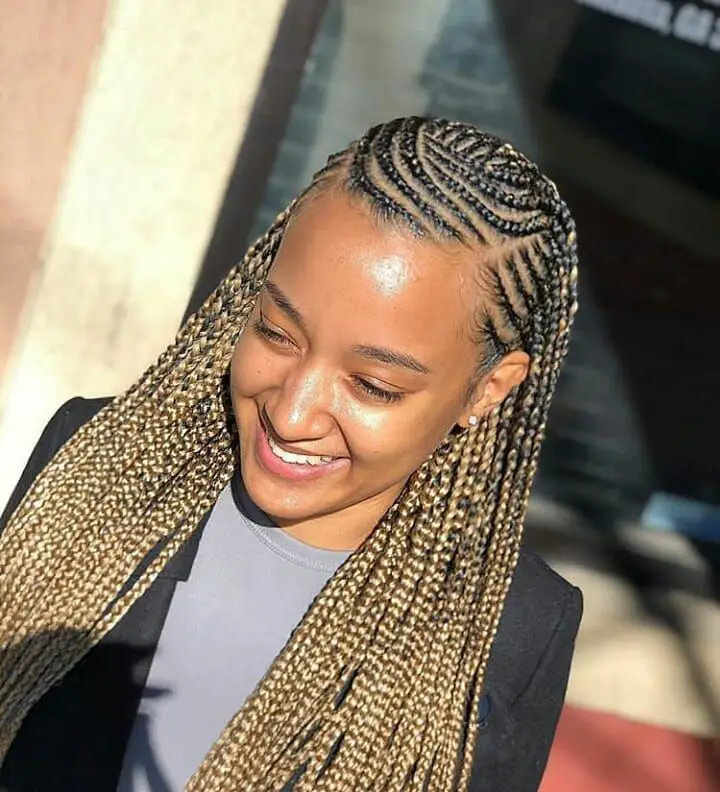What’s a “braid”?
A braid (or “plait”) is any hairstyle created by interlacing three or more strands of hair. It’s a technique used across many cultures, for both function and style.
Because “braids” is such a broad term, it covers everything from simple three-strand plaits, to complex multi-strand patterns, to forms that lie flat against the scalp or hang loose.
Table of Contents
What are cornrows?

Cornrows are a more specific style: the hair is braided very close to the scalp, in continuous, raised rows or patterns. (Wikipedia)
They have a deep history in many African cultures and the African diaspora, and the term “cornrows” comes from comparisons with rows in corn (or sugar-cane) fields. (Wikipedia)
Key differences between braids vs cornrows
Here are some of the practical distinctions:
1. Technique & placement
- With braids in the broader sense, the hair may be sectioned and then braided, but the braid can hang away from the scalp.
- With cornrows, each braid is tightly braided onto the scalp, following a row or pattern. (Wikipedia)
2. Appearance & styling possibilities
- Braids (in general) allow a wide variety of looks—loose hanging braids, box braids, fishtail braids, etc.
- Cornrows typically offer a sleek look, often patterned (straight rows, curves, geometric shapes) and are closer to the head. (JALIZA)
3. Time, maintenance, and wear
- Because braids (when free-hanging) aren’t always anchored to the scalp, the skill and time depend on length, thickness, and complexity.
- Cornrows often take less time to install compared to large free-hanging braided styles, but because they hug the scalp they require care to avoid tension. (Virgo Hair Braiding)
- Both styles need good maintenance, but because cornrows are closer to the scalp, they can be easier to keep neat for active lifestyles. (Edge Naturale)
4. Function & lifestyle fit
- If you’re looking for versatility—braids you can pull into buns, ponytails, half-up styles, etc.—braids (in the broader sense) give you that.
- If you want something flat to the scalp (for sport, heat, sleeping comfort, or low-profile living), cornrows might be better.
- One caution: if cornrows are done very tight or worn for long without care, there’s risk of tension-related issues. (Wikipedia)
5. Cultural significance
- Both braids and cornrows have cultural roots, but cornrows are especially significant in many African and diaspora communities as markers of identity, history and aesthetics. (Wikipedia)
- Using the proper terminology and recognising the origins matters when styling, taking inspiration, or choosing a look.
Which to choose—and how
Since you mentioned you’re half Tanzanian, half Ugandan and living in Africa, here are some considerations you might make:
- Think hair texture: tightly-coiled or textured hair responds well to both styles, but the anchoring of cornrows can help maintain shape and neatness especially in humid climates or with active movement.
- Think scalp comfort: if you sit for long hours (e.g., with a laptop on your lap) or sleep in certain positions, a style with less bulk on top may feel better—cornrows or small-section braids might be easier.
- Think styling versatility: If you enjoy changing up your look (half up, buns, adding extensions or colour), then free-hanging braids give more “play.”
- Think maintenance schedule: If you prefer low-maintenance routines, cornrows might require fewer daily adjustments.
- Think hair health: Avoid excessive tension. Whether cornrows or loose braids, too-tight installation or leaving the style in too long can harm the scalp or hair follicles.

Photo Credits: Coveteur, Maria
READ ALSO: Box Braid Hair 2023: A Bold Statement in Hair Fashion